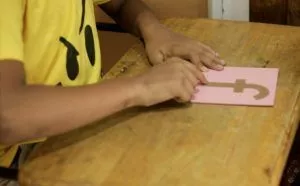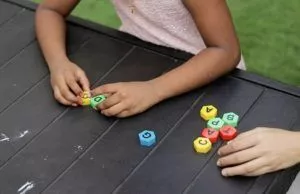
Written by
Mary Divya K Thomas, M.A., B.Ed (ID),
Special Educator
We understand and learn better when we use different senses such as vision, hearing, movement and touch. Learning through senses helps us retain the information in our minds for a longer time, and makes learning more interesting.
While all learners use all the four senses such as Visual(seeing), Auditory(hearing), Kinesthetic(movement) and Tactile(touch), one or two senses among these will be dominant for each learner. A multisensory learning approach helps determine the learner’s preferred or dominant learning style. Their preferred learning style helps them learn new things easily. Some people can also have a mixed blend of all these four styles. A learner may prefer one style for learning something and another for a different task.
What is Multisensory Learning?
Multisensory learning is a teaching method that helps learners to learn using more than one sense i.e. visual, auditory, kinesthetic and tactile sense. It is an effective method that ensures inclusive learning and teaching. The different types of sensory learning involve,
- Visual – Learning visually through pictures, videos or any images that you see through the eyes
- Auditory – Learning through hearing and listening
- Tactile – Learning through touch
- Kinesthetic – Learning through movements
How Exactly Does Multisensory Learning Work?
We remember things more accurately when we experience them through more than one of our senses. When we teach children utilizing multiple sensory inputs, it helps them retain the things learned. As different parts of the brain are involved while we learn through different senses, learning becomes interesting and children can remember things being taught better.
For example, a child, who has difficulty processing visual information, may find it challenging to learn and remember information via reading or visual stimuli. When the teacher introduces touch or auditory senses in the learning process, the child finds it easier to make stronger connections with what he/she is learning.
Benefits of Multisensory Learning
- It is beneficial for all kinds of learners
- Sustains memory as it uses the whole brain
- Learning becomes interesting and engaging
- It can be beneficial for children with special needs
- It helps reduce the pressure of learning
Multisensory Learning Resources and Materials
Multisensory learning is effective when a teacher incorporates the preferred learning style of a learner while teaching. There are effective ways of teaching using multisensory learning resources according to each child’s needs.
Videos/Images
Videos and images are beneficial for all kinds of learners as they help them to remember things better. Learning through video creates more cognitive connections in the brain and will give the learner a more in-depth understanding.
It is useful for learners who are interested in looking around and seeing what is displayed on the wall or for children interested to look at a person’s face eagerly when they speak.
The visual representation through images or videos helps the learner understand what is being taught more effortlessly and creates a link with what they already know. This helps in retaining the content better.
Audios
When taking notes, auditory learners find learning easier if they can store the information as audio recordings. These recordings can be someone reading the notes, explaining a problem or a lecture.
Clay, Sand and Sandpaper
These hands-on materials are primarily used for learners who like to learn by themselves. This will benefit learners who need to touch and feel what is being taught.
Air Writing
Writing in the air with a finger helps them create a relation with what is taught. As a child writes an alphabet in the air, an impression of the letter will be formed and it will add to their memory.
Movement games /jumping activity
We usually hear about kids who are moving around in a classroom. We can add games or activities that would satisfy both the child and the teacher. Children learn more through these activities as most learners like movement, and it creates a lasting impression in their memory.
Multisensory Learning Can Be Used To teach All Subjects In Classroom
Multisensory instructions can be used in all disciplines of study. It is an effective way to introduce concepts. Introducing the concepts through a multisensory approach will help the learner connect or associate them with other topics discussed or learnt more comfortably.
Teaching Techniques of Multisensory
Multisensory teaching techniques stimulate learning by engaging students at multiple levels. Students learn more effectively when taught using techniques that cater to their learning styles. Some of the techniques used are:-
Visual Reasoning and Learning
- Visual teaching methods and strategies often include text, pictures, posters, models, flashcards, computers, and projection screens.
- Graphically organising things, outlining passages
- Videos and pictures
- Using colours for highlighting
- Adaptive Reading Material

Auditory Techniques
Techniques used include,
- Peer-assisted reading, paired reading or computerised text readers, and books on tape.
- Videos with audio
- Language games, music, song, instruments, etc.
Tactile Teaching Techniques
Tactile techniques are for those who love to touch and learn. The different techniques include,
- Manipulatives like base ten blocks, pattern blocks, and geared clocks can be used to teach concepts
- Sand trays, textured objects, finger paints
- Clay, shaving cream, modelling materials

Kinesthetic Techniques
Kinesthetic teaching techniques include,
- Activities involving movement like air writing, jumping, clapping, and dancing
- Bean bag tossing, flashcard races, and learning games which involve movement
- Games and other activities involving movement which include concepts
How does Multisensory Learning Enhance Reading Skills?
Multisensory learning helps learners connect with what they are learning. This approach can help them memorise what they learn as it is a holistic approach involving all senses. When they see a word and form it with the alphabet tiles or play games to form the word, the learned concepts will stay in their memory. Some of the techniques that are used in helping kids to improve reading skills are sand or shaving cream writing, air writing, sandpaper letters, word building etc.

Multisensory Learning For Dyslexia
Learning can be made easier when all the senses are used, especially for learners struggling with reading. The multisensory approach is an important way of instruction for dyslexic students. Dyslexic students will have to be taught slowly and thoroughly so a lot of practice is needed. To make their learning interesting it is essential to create learning pathways. For example, if a child has to read a specific word, she will be asked to point to the image of that word and asked to make that word using alphabet tiles and then write the word in the sand and then on paper. This will help her in recalling what is taught more clearly.
Conclusion
Multisensory learning provides more ways for understanding new concepts or information, and more ways to remember or recall it later – especially for children who have difficulty remembering new information. Multi-sensory learning helps learn abstract concepts or concepts that consist of sequence or order more quickly and effectively. Learning new concepts through sight, touch, sound and movement helps break down all the barriers affecting learning. It creates new engaging channels to learn and recall.

FAQ
Sensory play helps to build nerve connections in the brain as it involves learning through exploration, curiosity, problem-solving and creativity. As development is focused on all areas including motor, cognitive, and language it supports learning most positively.
Sensory play engages the child to play with the senses. It helps develop learners’ language, motor, and cognitive skills. It improves their social interaction and makes them involve, experiment and experience learning more fruitfully.
Learning through sensory experience is a mode of learning that encourages children to use two or more of their senses. As it builds nerve connections within the brain, it supports child’s learning.
Sensory play is important in a classroom as there will be diverse learners. Through this play, children can engage in many sensory activities that can help develop the neural pathways that will help them comprehend things better.
Sensory play will be loads of fun and it will be exciting and interesting for toddlers to explore it. Some sensory activities for toddlers are
- playing with food (different textured)
- Sensory bin consisting of things having different textures
- play dough
- sand box
- plant a garden
- baking
- games (jumping, clapping etc)
- Using step-by-step directions and reading instructions
- Using and highlighting keywords or simplifying directions
- Practising frequently


